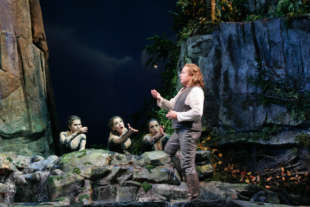Speight’s Wagner Memories: 05 RING

Jennifer Hines (Flosshilde), Wendy Hill (Woglinde), Mary Philips (Wellgunde), and Alan Woodrow (Siegfried) in Wagner’s Götterdämmerung, 2005
© Chris Bennion
We also had a problem with Hagen in all three cycles. Gidon Saks sang brilliantly in the dress rehearsals but before the first cycle he developed an upper respiratory infection that wouldn’t go away. He made it through Fafner in both Das Rheingold and Siegfried in all three cycles, but Hagen was too much for his condition. In each case I had to go before the curtain and make an excuse. In the second cycle it was so bad that we put on his cover for Acts II and III; in the other two he finished the opera. The whole experience was more than difficult for the singer and all of us. This Ring will be, I hope, the only time that I had to come out four times to discuss a physical problem of a singer; I don’t remember ever doing it before in a Ring.
Planning paid off in this Ring, the first one in McCaw Hall. When the Ring was originally presented in the old opera house, Robert Schaub had tried to foresee how the new Ring would work in McCaw Hall. The proscenium’s increased height made a huge difference, as part of the grandeur of the Ring is the appearance of the “stone” surfaces of Brünnhilde’s rock and similar scenes seemingly extending further than the audience can see. With a higher proscenium the top of the rocks would have been all too plainly visible. The solution was an ornate, carved decoration over the proscenium, designed very much in the style of the Gibichung Hall, with the title screen in the middle. It filled the added space and worked wonderfully.